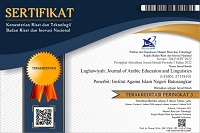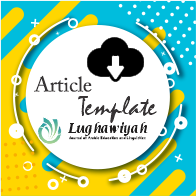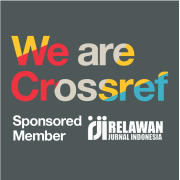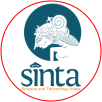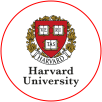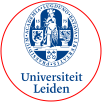TEACHING NAHW AND SHARF BY USING WHATSAPP (A CASE SUDY AT “BISA” FOUNDATION IN DEPOK, WEST JAVA, INDONESIA) / تعليم النحو و الصرف عبر الواتسأب (دراسة حالية في مؤسسة "بيسا" الإسلامية ديبوك إندونيسيا)
Abstract
Keywords
Full Text:
PDFReferences
أبو عمشة, خ. ح. وآخرانِ. 2015. تعليم اللغة العربيّة للناطقين بغيرها. أعمال المؤتمر الدُّولي الأول. اسطنبول. غير مطبوعة.
أسرارى , إ. 1995. الوسائل المعينات فى تعليم العربية. مالانج: جامعة مالانج الحكومية.
الفوزان، ع. ر. إ. 2011. إضاءات لمعلمي اللغة العربية لغير الناطقين بها. الرياض: مكتبة الملك فهد الوطنية أثناء النشر.
الشرهان, ج. ع. ع. 2016. الوسائل التعليمية ومستجدات تكنولجيا التعليم. الرياض: جامعة الملك سعود.
Allen, E. & Scaman, J. 2010. Learning ON Demand. Washington: Babson Survey Research Group.
Hope. 2006. Collaborative Learning: Group Interaction in an Intelligent Mobile-Assisted Multiple Language Learning System. Informatics in Education, 13 (2), 279-292.
Marlion, F. A. (2017). Metode Pendidikan Dipelajari dari Metode Bijak dalam Al-Quran. Tesis. Universitas Islam Negeri Syarif Hidayatullah Jakarta.
Munir, A. S. & Muassomah. 2021. Pembelajaran Bahasa Arab di Era Pandemi: Implementasi E-Learning di Sekolah Dasar Islamic Global School Kota Malang. LISANUL ARAB 10(1), 93-102. https://journal.unnes.ac.id/sju/laa/article/view
Prananingrum, A. V. & Kholis, M. N. 2020. Whatsapp sebagai Media Pembelajaran Bahasa Arab pada Masa Pandemic Covid-19. Proceeding NATHLA, 1(1), 129-136. https://e-proceedings.iain-palangkaraya.ac.id/index.php/natla/article/view/166
Sikwibele & Mungoo. 2009. Distance Learning and Teacher Education in Bostwana: Opportunities and Challenges. International Review of Research in Open and Distance Learning, 10 (4).
Yahya, M., Maftuhati, Mustofa, A. H. & Arifa, Z. 2021. Online-Based Arabic Learning Management During the Covid-19 Pandemic Era: Plan, Implementation and Evaluation. Al-Ta’rib, 9(1), 85-98. https://e-journal.iain-palangkaraya.ac.id/index.php/tarib/article/view/2505
DOI: http://dx.doi.org/10.31958/lughawiyah.v3i2.4804
Refbacks
- There are currently no refbacks.

This work is licensed under a Creative Commons Attribution-NonCommercial 4.0 International License.
Lughawiyah Indexed By:

Lughawiyah distribute under Lisensi Creative Commons Atribusi-NonKomersial 4.0 Internasional.
View My Stats lughawiyah
